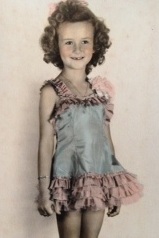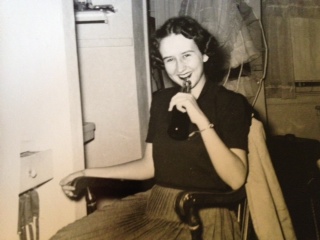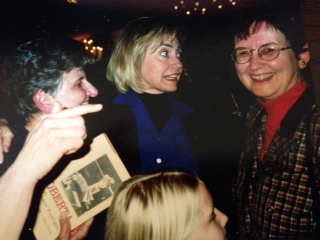NAN SNOW OF ARKANSAS
JOURNALIST,
MEMBER ARKANSAS STATUS OF WOMEN COMMISSION, BREAST CANCER SURVIVOR,
VOLUNTEER IN BILL CLINTON’S ARKANSAS ADMINISTRATION
AND IN THE CLINTON WHITE HOUSE
 |
|
Nan Snow 1970s |
I was born in Carnegie, Oklahoma, in 1936, at the southern edge of the Dust Bowl during the Great Depression. My parents had left their Arkansas home to seek bridge construction work
in Oklahoma. By this time, Works Progress Administration (WPA) construction projects were under way, my father found work, and for several years we crisscrossed Oklahoma living wherever a bridge was being built. We left Carnegie when I was six months old and did not return. Finally, out of curiosity, I returned in the early 1990s to stand by the bridge my father had built, the doctor's office where I was born, and the house where we lived.
Imagine! They were all still standing after all those years.
As World War II got underway, we were living in Tulsa, Oklahoma, where my father was working for the DuPont Company. In the middle of the war, he was sent to work in Washington state. My father was assigned to work at the Hanford Reservation. I still remember him coming home and saying to my mother and me that he didn't know what he was working on - it was top secret - but he had never built walls as thick. It was only at war's end that we learned he was helping build an atomic bomb plant.
Living
in Washington was a memorable experience for me. It was at the
height of World War II. We listened to the war news every
day on the radio and grieved whenour
next-door neighbor's son was killed in the Battle of the Bulge. It
was in Washington that
I first attended an integrated school. I still recall that the
unofficial class leader was
an African-American girl who demonstrated impressive abilities at that
early age. Over
the years, I have often wondered what became of her, but because I cannot
recall
her name, I will never know.
Little Nan
Snow

At war's end, we returned to the family home in Harrison, Arkansas, so that I, an only child, could receive a stable education. Harrison, which dubbed itself Hub of theOzarks, was an idyllic place to grow up. The beauty of the mountains provided a perfect setting for hiking, swimming and enjoying the outdoors. Girls and boys alike took advantage of it. However, it was there, in high school, that I had my first "aha!" feminist moment. A group of us girls loved to play basketball, We went to the schoolsuperintendent and requested that we have a girls' high school basketball team. He said no, it wasn't "lady-like." And besides, did we want to be like those girls in thecountry schools surrounding Harrison that did have teams? We said yes, but to no avail. Little did I know then, that years later I would write a master's course paper onTitle IX and its role in women's athletics.
After high school graduation, I attended Arkansas State Teachers College (now the University of Central Arkansas). By this time I knew I wanted to be a journalist, having had two grandfathers who had owned two small-town newspapers. I majored in journalism, serving as editor of the student newspaper, and working in the public relations office where I wrote press releases for the college. It was there I met, and later married Ken Snow. Ken had moved away from Harrison the yearbefore I moved there and I had heard so much about him from my friends, I felt as if I knew him before we ever met. He was a member of the college baseball team, and we have both shared a lifetime love of baseball too. We have made Little Rock, Arkansas, our home all of our married life. We have no children. Ken is now retired from a career in the federal service as a loan officer with the U.S. Small Business Administration.
 |
|
Nan in the college years |
I worked as a newspaper reporter and advertising agency copywriter following graduation. When Ken and I moved to Little Rock, I applied for work as a city-beat reporter at the venerable Arkansas Gazette, a Pulitzer Prize-winning newspaper, honored for its fair and compassionate coverage of the 1957 Central High Schoolintegration crisis. Alas, in 1959, I was told by the editor that women were not allowed in the city room: my second "aha!" moment. Two years later they had become used to me providing them press releases for the advertising agency for which I worked, all, that is, but the sports editor who never knew that sports writing was part of my reporting work. They finally offered me a general assignment reporter position. I took great pleasure in turning it down.
By this time, my interest in public service had led to work in the federal service. While with the U. S. Office of Personnel Management, I was appointed Federal Women's Program Coordinator for the five-state region of Arkansas, Louisiana, New Mexico, Oklahoma and Texas. It was also about this time that "The Feminine Mystique" became a popular topic. I was an immediate convert and later signed on to membership in NOW and the Arkansas Women's Political Caucus. While some people refuse to see Arkansas in a progressive light, I believe we formed a strong cadre of feminist women in our state. At the same time, as an affirmative action officer forthe federal government, I began to work for minority rights and against racial prejudice, always remembering my positive experience as a young schoolgirl in Washington.
During this time, in the early 1970s, I also served
on the Arkansas Governor's Commission on the Status of Women chaired by
Diane Kincaid Blair, a University of Arkansas professor for whom the
university's Blair Center for Southern Politics and Society is now
named. Under Diane's leadership, our 1973 Commission issued a
landmark report on "The Status of Women in Arkansas" In 2013, the
report is being celebrated on its 40th anniversary. The Women's
Foundation of Arkansas, in cooperation with students at the Clinton School
of Public Service in Little Rock, have published an updated report of
women's status in 2013. Also the Blair Center and the Clinton School
will join forces to mark the anniversary with special events.
 |
|
Nan Snow, Diane Stuck outside Robert Fullbright Dining Hall |
Also while serving as Federal Women's Program Coordinator, I became acquainted with Dorothy D. Stuck, a former Arkansas newspaper editor and publisher, and then Dallas Regional Director of HEW's Office for Civil Rights. Together we traveled the region conducting upward mobility seminars for women employees. We later left the federal service to establish a management and publications consulting firm in Little Rock which we brilliantly named Stuck & Snow Resultants. We couldn't resist the lure of combining those "catchy" names, and Dorothy dubbed us Resultants, because she wanted us to be consultants who got results for our clients.
After
retiring 15 years later, in the 1990s, we embarked on a project dear to
our hearts.
Believing that the accomplishments of Arkansas women had been
largelyomitted
from the state's history, we wrote a biography of Roberta Fulbright, known
as
the mother of Senator J. William Fulbright, but never for her own
accomplishments
as a newspaper publisher and columnist, influential voice in state politics, and savvy business owner. The book, "ROBERTA: A Most Remarkable Fulbright," reached bestseller lists in Arkansas and received a commendation from the National Association of State and Local History. Imagine, too, our pleasure when we attendedthe dedication in October 2012 of the new Roberta Fulbright Dining Hall on the University of Arkansas campus. After co-authoring "ROBERTA," I wrote another book,"Letters Home," a World War II memoir, which also reached the state's bestseller lists.
 |
|
Hillary Clinton, Nan Snow |
I became acquainted with Hillary Clinton in 1981 when Dorothy Stuck and I attended a conference analyzing Bill Clinton's loss to Frank White in a race for the Arkansas governorship. Hillary made an impressive presentation at the conference, and we were so impressed, we invited her to lunch and a friendship was born. She and Dorothy then served together on the board of the Southern Development Bancorporation. Dorothy and I formed a small informal group of women during the 1980s who sometimes came by our office before work to share experiences and ideas. Hillary, then Arkansas's First Lady, and Joycelyn Elders, later to become U.S. Surgeon General, came when they could spare the time. I was impressed with Hillary then and I remain even more so today.
I served two volunteer appointments in Bill Clinton's Arkansas administration. Because of my interest in education, I was appointed to chair the Technical Education Advancement Study Committee to make recommendations to the state legislature on the improvement of post-secondary technical education in Arkansas. I also served on the Governor's Advisory Council on Vocational-Technical Education. I then worked briefly in the Arkansas transition team office as he transitioned from Arkansas to the presidency. It is a still a joy to see him come home now on frequent occasions to the Clinton Presidential Center and hear him still talking Arkansas politics.
In the early days of 1993 when Bill Clinton became President, Hillary was swarmed with a mountain of correspondence. She invited five friends - including Dorothy Stuck and me - to spend several days in the White House to help clear the backlog of correspondence she had received. She joined us in the evenings in the White House when she could.
The
experience was memorable on its own, but was made even more so by a
previous experience.
I had worked one summer in Washington, D. C.years before, while I was
in
college. Many was the time I had stood outside the White House gates
and wondered what it was like inside. Little did I know that years
later I would find out. What an experience Hillary gave us
all.
|
|
|
Nan Snow and 5 friends at
|
In addition to an abiding interest in politics and government, I have also taken time to
volunteer in other areas of interest and concern. I have served on the boards of the Butler Center for Arkansas Studies, the Arkansas Women's History Institute, Encore for Women's Health, and the University of Central Arkansas Foundation.
As a 16-year breast cancer survivor, I have served as president of the Arkansas Affiliate of Susan G. Komen for the Cure. In a fundraising effort, I convinced three other breast cancer survivors to participate in a project I called 4 Survivors, 4 Rivers 4 a Cure. Together, we novices rafted four white water rivers in Arkansas, Colorado and Utah, raising $10,000 for the cause and risking life and limb. We four agree we wouldn't take anything for the experience, but we also wouldn't do it again.
On a calmer note, I am currently a member of the advisory board of the Archives of Women of the Southwest at Southern Methodist University, my graduate school alma mater where I received master's degrees in liberal arts and in public administration. We are assisting the SMU Central University Libraries in funding and maintaining archives of women and women's organizations throughout the southwest.
In January 2013, Dorothy Stuck and I joined the other Arkansas Travelers for a reunion of the group which campaigned across the country for Bill Clinton and later for Hillary Clinton in their runs for the presidency. The Clinton Presidential Center in Little Rock is now featuring a special Arkansas Travelers exhibit. I invite anyone traveling this way to stop by and see what citizens can do in politics when fervent about a candidate or a cause.
I
entered the world of work at a time when it was extremely difficult for
women to obtain
professional positions, but since this was soon followed by the
feminist
movement,
I credit it with opening doors. Also, I have been fortunate to have
had women
role models along the way such as Dorothy Stuck, Diane Blair, and
Elly
Peterson, also a dear friend and former co-chair of ERAmerica. I had only to observe them to know what I needed to do to.
Today,
I enjoy retirement, volunteering for the organizations I have
mentioned. Ken, too
volunteers with the AT&T Pioneers who have made him an honorary member
for
helping
them build wheel-chair ramps for persons in need in the Little Rock area.
We
also enjoy traveling and go to the West whenever we can. We
sometimes
spend part of the summer in Colorado or Arizona.
It
has been quite a ride, the rafting experience especially. I have
participated in the 1960s-70s
women's movement while pursuing my passion for women's
equality,
including their history, education, employment and health. Thanks VFA!
Contact Nan Snow Kenansnow@aol.com
Comments Jacqui Ceballos jcvfa@aol.com
